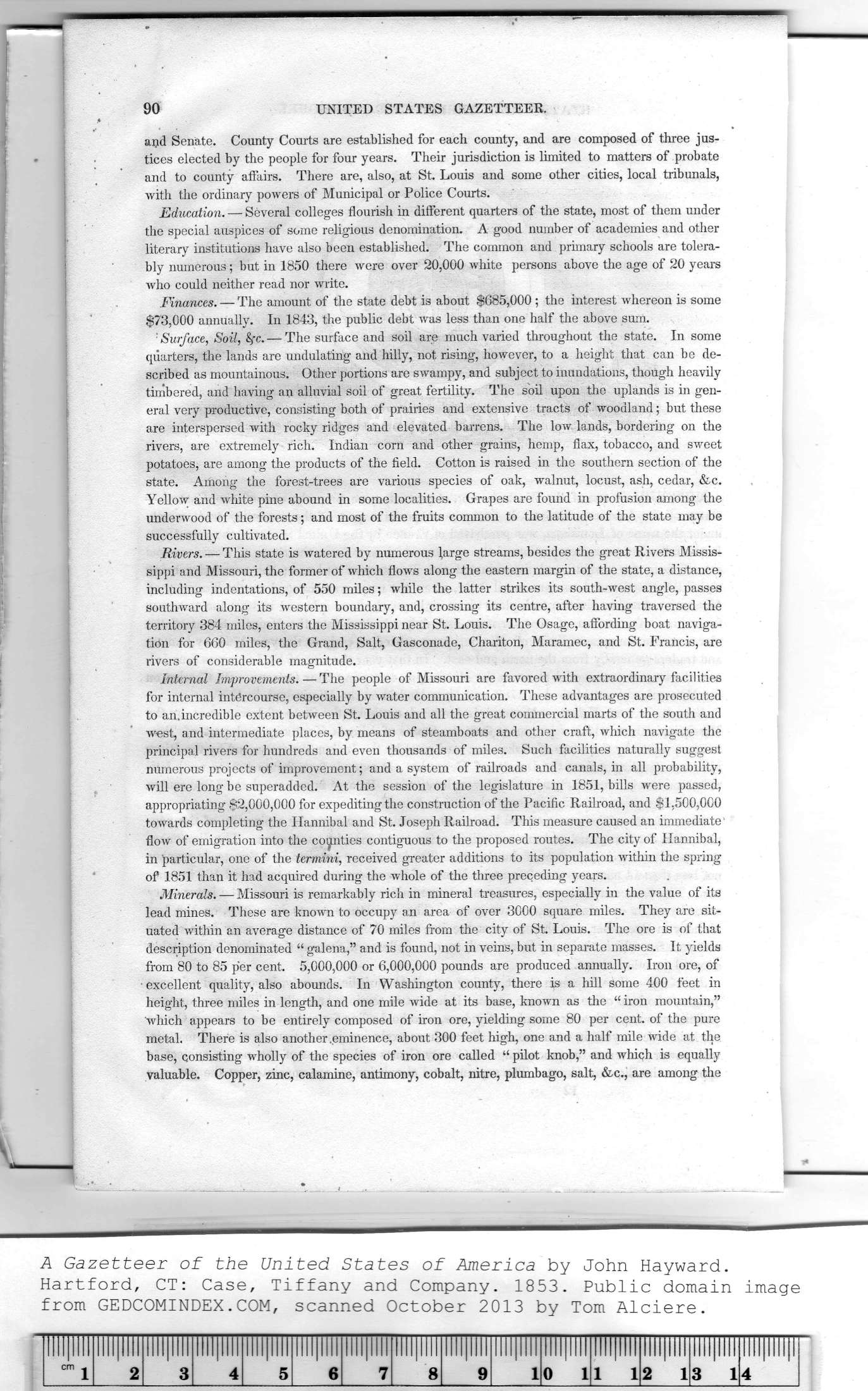|
|
Note: Ctrl and + increases the font size of the text below, Ctrl and - decreases it, and Ctrl and 0 resets it to default size.
i
90 UNITED STATES GAZETTEER
| and Senate. County Courts are established for each county, and are composed of three jus-
j . ! . tices elected by the people for four years. Their jurisdiction is limited to matters of probate
j : and to county affairs. There are, also, at St. Louis and some other cities, local tribunals,
; with the ordinary powers of Municipal or Police Courts.
j Education. — Several colleges flourish in different quarters of the state, most of them under
[ j the special auspices of some religious denomination. A good number of academies and other
| literary institutions have also been established. The common and primary schools are tolera-
| bly numerous; but in 1850 there were over 20,000 white persons above the age of 20 years
! who could neither read nor write.
' Finances. — The amount of the state debt is about $685,000 ; the interest whereon is some
$73,000 annually. In 1843, tire public debt was less than one half the above sum.
Surface, Soil, fyc.— The surface and soil are much varied throughout the state. In some
^ quarters, the lands are undulating and hilly, not rising, however, to a height that can be de-
scribed as mountainous. Other portions are swampy, and subject to inundations, though heavily
timbered, and having an alluvial soil of great fertility. The soil upon the uplands is in gen-
i eral very productive, consisting both of prairies and extensive tracts of woodland; but these
! are interspersed with rocky ridges and elevated barrens. The low lands, bordering on the
rivers, are extremely rich. Indian com and other grains, hemp, flax, tobacco, and sweet
; potatoes, are among the products of the field. Cotton is raised in the southern section of the
: state. Among the forest-trees are various species of oak, walnut, locust, ash, cedar, &c.
Yellow and white pine abound in some localities. Grapes are found in profusion among the
underwood of the forests; and most of the fruits common to the latitude of the state may be
successfully cultivated.
Rivers. — This state is watered by numerous large streams, besides the great Rivers Missis-
• sippi and Missouri, the former of which flows along the eastern margin of the state, a distance,
including indentations, of 550 miles; while the latter strikes its south-west angle, passes
southward along its western boundary, and, crossing its centre, after having traversed the
territory 384 miles, enters the Mississippi near St. Louis. The Osage, affording boat naviga-
tion for 660 miles, the Grand, Salt, Gasconade, Chariton, Maramec, and St. Francis, are
rivers of considerable magnitude.
Internal Improvements.—The people of Missouri are favored with extraordinary facilities
for internal intercourse, especially by water communication. These advantages are prosecuted
to an. incredible extent between St. Louis and all the great commercial marts of the south and
west, and intermediate places, by means of steamboats and other craft, which navigate the
principal rivers for hundreds and even thousands of miles. Such facilities naturally suggest
numerous projects of improvement; and a system of railroads and canals, in all probability,
will ere long be superadded. At the session of the legislature in 1851, bills were passed,
appropriating $2,000,000 for expediting the construction of the Pacific Railroad, and $1,500,000
towards completing the Hannibal and St. Joseph Railroad. This measure caused an immediate'
flow of emigration into the counties contiguous to the proposed routes. The city of Hannibal,
in particular, one of the termini, received greater additions to its population within the spring
of 1851 than it had acquired during the whole of the three preceding years.
Minerals. — Missouri is remarkably rich in mineral treasures, especially in the value of its
lead mines. These are known to occupy an area of over 3000 square miles. They are sit-
uated within an average distance of 70 miles from the city of St. Louis. The ore is of that
description denominated “ galena," and is found, not in veins, but in separate masses. It yields
from 80 to 85 per cent. 5,000,000 or 6,000,000 pounds are produced annually. Iron ore, of
•excellent quality, also abounds. In Washington county, there is a hill some 400 feet in
height, three miles in length, and one mile wide at its base, known as the “ iron mountain,"
which appears to be entirely composed of iron ore, yielding some 80 per cent, of the pure
metal. There is also another .eminence, about 300 feet high, one and a half mile wide at the
base, consisting wholly of the species of iron ore called “ pilot knob," and which is equally
valuable. Copper, zinc, calamine, antimony, cobalt, nitre, plumbago, salt, &c., are among the
V
|
Illllllll |
Illllllll |
Illllllll |
llll llll |
Illllllll |
Illllllll |
llll|llll |
fllMIII|llll |
Illllllll |
Illllllll |
Illllllll |
Illllllll |
Illllllll |
|
|
cm j |
2 |
3 |
4 |
5 |
6 |
7 |
8 9 |
1 |
0 1 |
1 1 |
2 1 |
3 1 |
4 |
|
